FIAT TIPO 4DOORS 2016 1.G Manual PDF
Manufacturer: FIAT, Model Year: 2016, Model line: TIPO 4DOORS, Model: FIAT TIPO 4DOORS 2016 1.GPages: 204, PDF Size: 4.94 MB
Page 71 of 204
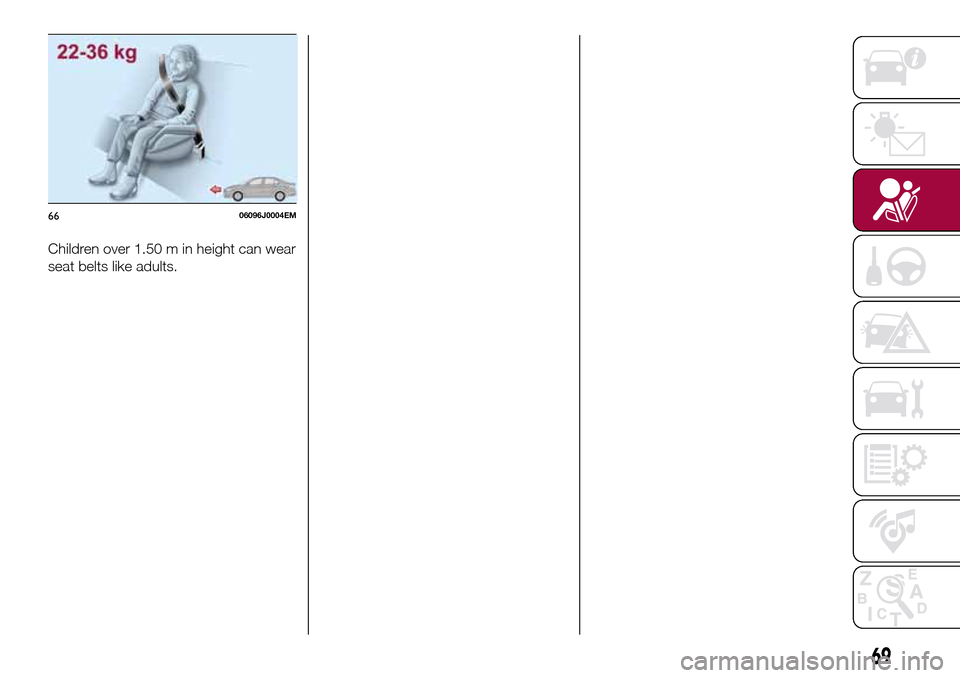
Children over 1.50 m in height can wear
seat belts like adults.
6606096J0004EM
69
Page 72 of 204
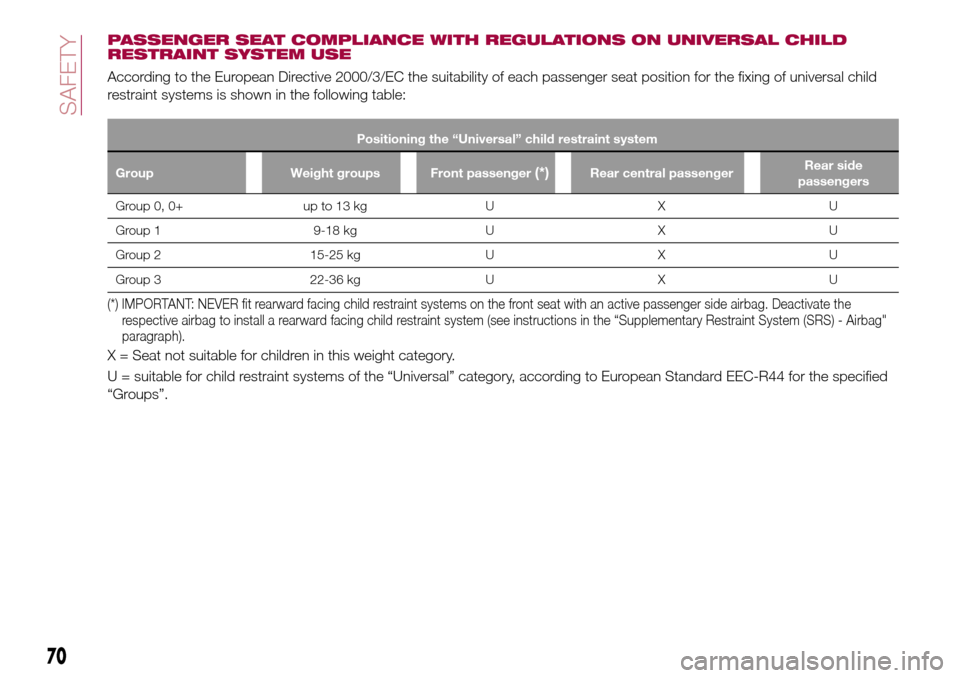
PASSENGER SEAT COMPLIANCE WITH REGULATIONS ON UNIVERSAL CHILD
RESTRAINT SYSTEM USE
According to the European Directive 2000/3/EC the suitability of each passenger seat position for the fixing of universal child
restraint systems is shown in the following table:
Positioning the “Universal” child restraint system
Group Weight groups Front passenger
(*)Rear central passengerRear side
passengers
Group 0, 0+ up to 13 kg U X U
Group 1 9-18 kg U X U
Group 2 15-25 kg U X U
Group 3 22-36 kg U X U
(*) IMPORTANT: NEVER fit rearward facing child restraint systems on the front seat with an active passenger side airbag. Deactivate the
respective airbag to install a rearward facing child restraint system (see instructions in the “Supplementary Restraint System (SRS) - Airbag"
paragraph).
X = Seat not suitable for children in this weight category.
U = suitable for child restraint systems of the “Universal” category, according to European Standard EEC-R44 for the specified
“Groups”.
70
SAFETY
Page 73 of 204
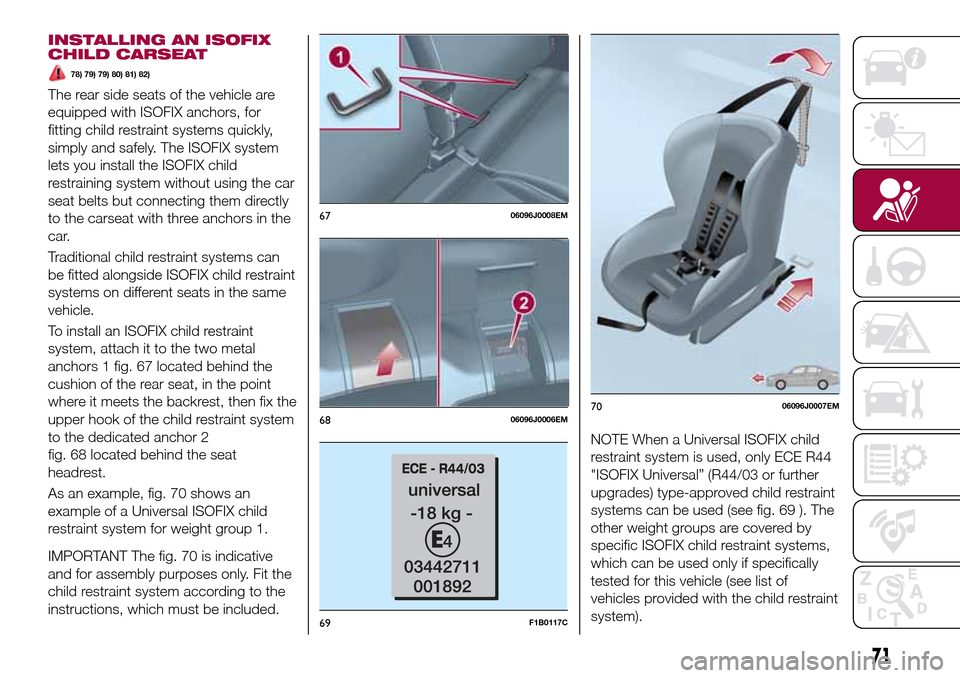
INSTALLING AN ISOFIX
CHILD CARSEAT
78) 79) 79) 80) 81) 82)
The rear side seats of the vehicle are
equipped with ISOFIX anchors, for
fitting child restraint systems quickly,
simply and safely. The ISOFIX system
lets you install the ISOFIX child
restraining system without using the car
seat belts but connecting them directly
to the carseat with three anchors in the
car.
Traditional child restraint systems can
be fitted alongside ISOFIX child restraint
systems on different seats in the same
vehicle.
To install an ISOFIX child restraint
system, attach it to the two metal
anchors 1 fig. 67 located behind the
cushion of the rear seat, in the point
where it meets the backrest, then fix the
upper hook of the child restraint system
to the dedicated anchor 2
fig. 68 located behind the seat
headrest.
As an example, fig. 70 shows an
example of a Universal ISOFIX child
restraint system for weight group 1.
IMPORTANT The fig. 70 is indicative
and for assembly purposes only. Fit the
child restraint system according to the
instructions, which must be included.
NOTE When a Universal ISOFIX child
restraint system is used, only ECE R44
"ISOFIX Universal” (R44/03 or further
upgrades) type-approved child restraint
systems can be used (see fig. 69 ). The
other weight groups are covered by
specific ISOFIX child restraint systems,
which can be used only if specifically
tested for this vehicle (see list of
vehicles provided with the child restraint
system).
6706096J0008EM
6806096J0006EM
69F1B0117C
7006096J0007EM
71
Page 74 of 204
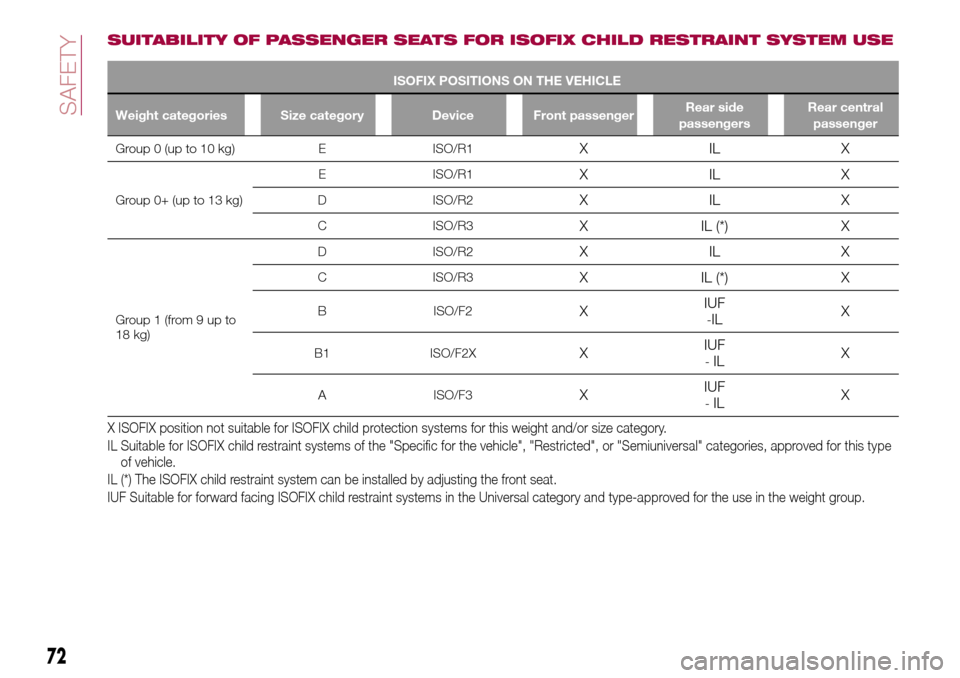
SUITABILITY OF PASSENGER SEATS FOR ISOFIX CHILD RESTRAINT SYSTEM USE
ISOFIX POSITIONS ON THE VEHICLE
Weight categories Size category Device Front passengerRear side
passengersRear central
passenger
Group 0 (up to 10 kg) E ISO/R1XILX
Group 0+ (up to 13 kg)E ISO/R1
XILX
D ISO/R2XILX
C ISO/R3X IL (*) X
Group 1 (from 9 up to
18 kg)D ISO/R2
XILX
C ISO/R3X IL (*) X
B ISO/F2XIUF-ILX
B1 ISO/F2XXIUF-ILX
A ISO/F3XIUF-ILX
X ISOFIX position not suitable for ISOFIX child protection systems for this weight and/or size category.
IL Suitable for ISOFIX child restraint systems of the "Specific for the vehicle", "Restricted", or "Semiuniversal" categories, approved for this type
of vehicle.
IL (*) The ISOFIX child restraint system can be installed by adjusting the front seat.
IUF Suitable for forward facing ISOFIX child restraint systems in the Universal category and type-approved for the use in the weight group.
72
SAFETY
Page 75 of 204
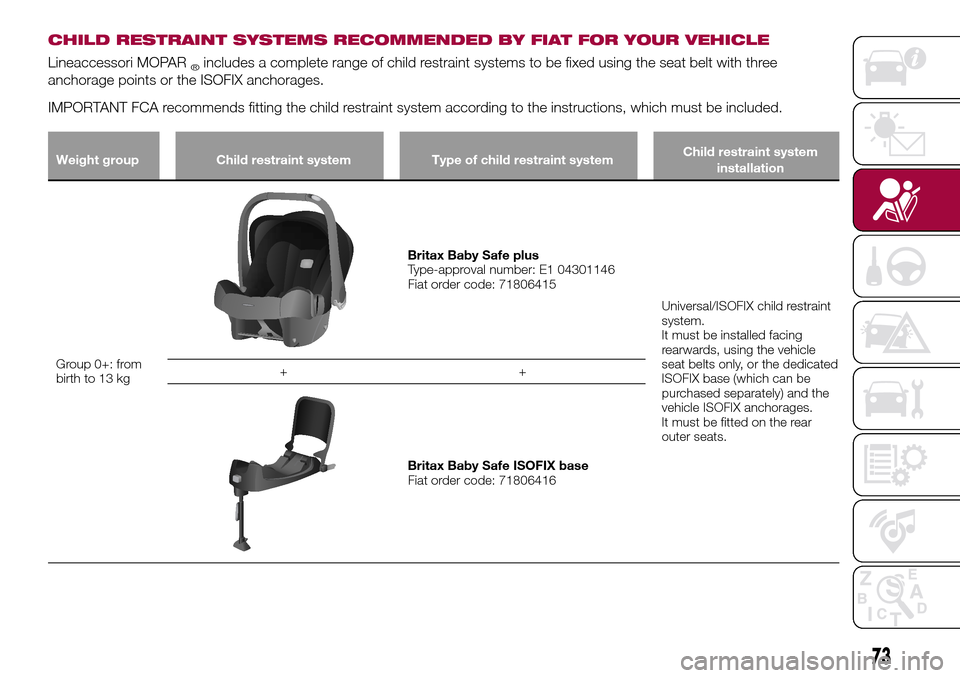
CHILD RESTRAINT SYSTEMS RECOMMENDED BY FIAT FOR YOUR VEHICLE
Lineaccessori MOPAR®includes a complete range of child restraint systems to be fixed using the seat belt with three
anchorage points or the ISOFIX anchorages.
IMPORTANT FCA recommends fitting the child restraint system according to the instructions, which must be included.
Weight group Child restraint system Type of child restraint systemChild restraint system
installation
Group 0+: from
birth to 13 kg
Britax Baby Safe plus
Type-approval number: E1 04301146
Fiat order code: 71806415
Universal/ISOFIX child restraint
system.
It must be installed facing
rearwards, using the vehicle
seat belts only, or the dedicated
ISOFIX base (which can be
purchased separately) and the
vehicle ISOFIX anchorages.
It must be fitted on the rear
outer seats. ++
Britax Baby Safe ISOFIX base
Fiat order code: 71806416
73
Page 76 of 204
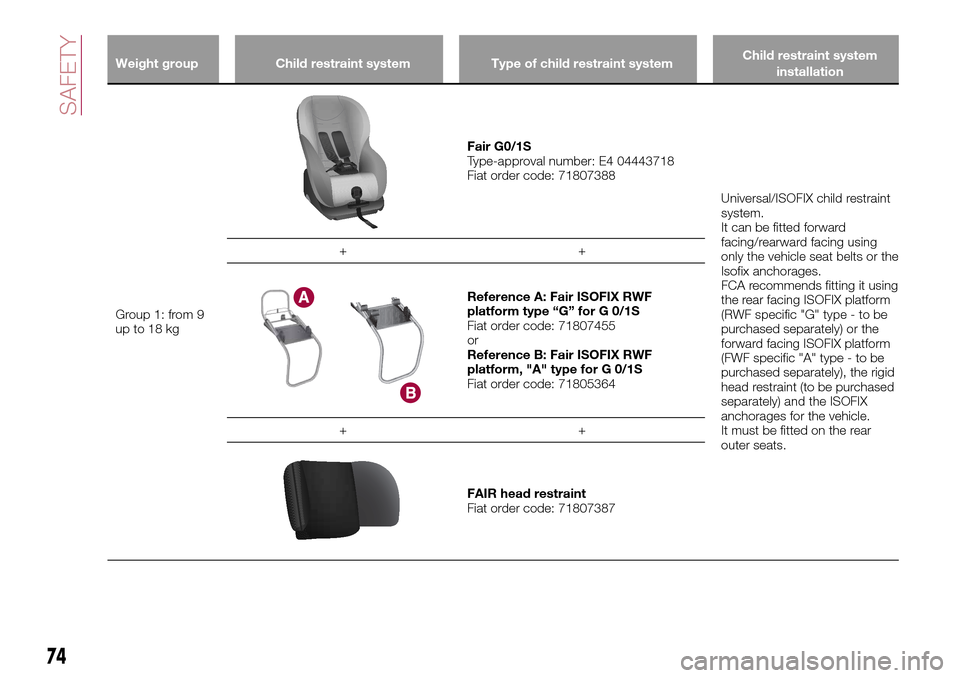
Weight group Child restraint system Type of child restraint systemChild restraint system
installation
Group 1: from 9
up to 18 kg
Fair G0/1S
Type-approval number: E4 04443718
Fiat order code: 71807388
Universal/ISOFIX child restraint
system.
It can be fitted forward
facing/rearward facing using
only the vehicle seat belts or the
Isofix anchorages.
FCA recommends fitting it using
the rear facing ISOFIX platform
(RWF specific "G" type - to be
purchased separately) or the
forward facing ISOFIX platform
(FWF specific "A" type - to be
purchased separately), the rigid
head restraint (to be purchased
separately) and the ISOFIX
anchorages for the vehicle.
It must be fitted on the rear
outer seats. ++
Reference A: Fair ISOFIX RWF
platform type “G” for G 0/1S
Fiat order code: 71807455
or
Reference B: Fair ISOFIX RWF
platform, "A" type for G 0/1S
Fiat order code: 71805364
++
FAIR head restraint
Fiat order code: 71807387
74
SAFETY
Page 77 of 204
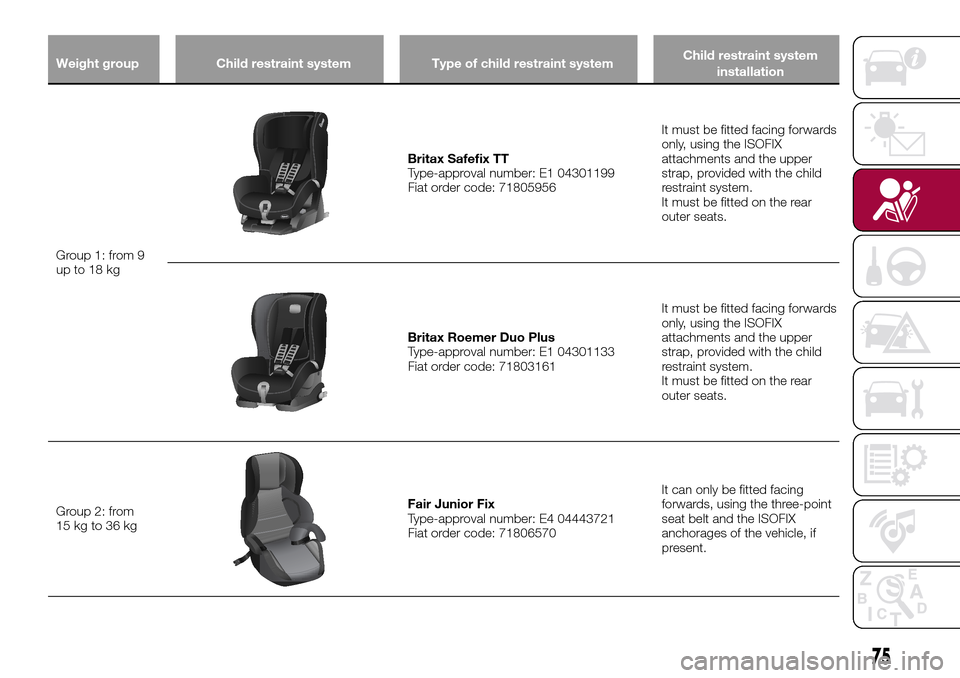
Weight group Child restraint system Type of child restraint systemChild restraint system
installation
Group 1: from 9
up to 18 kg
Britax Safefix TT
Type-approval number: E1 04301199
Fiat order code: 71805956It must be fitted facing forwards
only, using the ISOFIX
attachments and the upper
strap, provided with the child
restraint system.
It must be fitted on the rear
outer seats.
Britax Roemer Duo Plus
Type-approval number: E1 04301133
Fiat order code: 71803161It must be fitted facing forwards
only, using the ISOFIX
attachments and the upper
strap, provided with the child
restraint system.
It must be fitted on the rear
outer seats.
Group 2: from
15 kg to 36 kg
Fair Junior Fix
Type-approval number: E4 04443721
Fiat order code: 71806570It can only be fitted facing
forwards, using the three-point
seat belt and the ISOFIX
anchorages of the vehicle, if
present.
75
Page 78 of 204
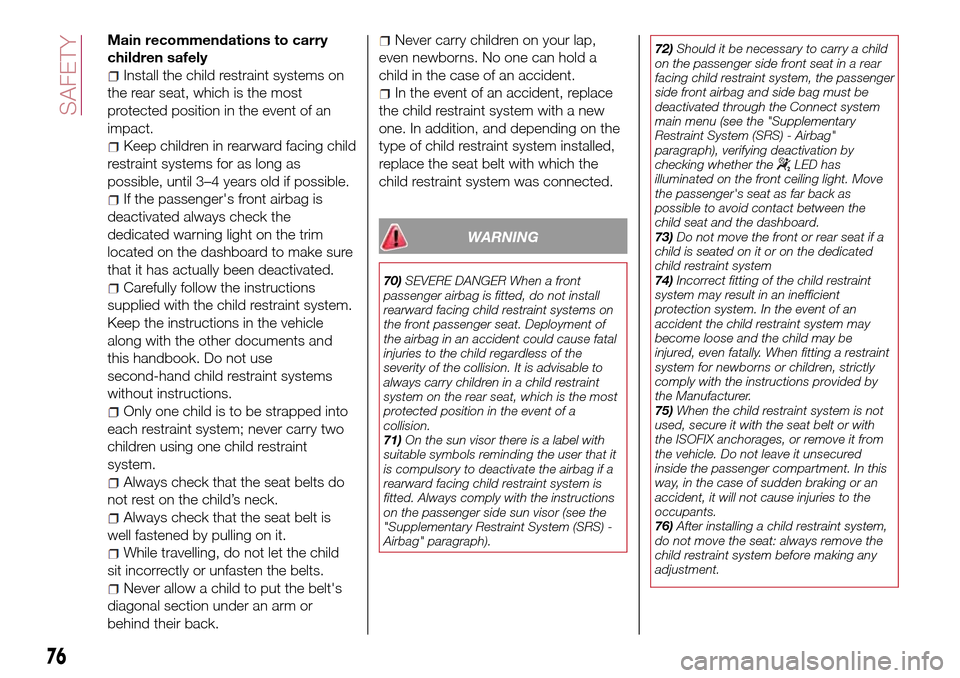
Main recommendations to carry
children safely
Install the child restraint systems on
the rear seat, which is the most
protected position in the event of an
impact.
Keep children in rearward facing child
restraint systems for as long as
possible, until 3–4 years old if possible.
If the passenger's front airbag is
deactivated always check the
dedicated warning light on the trim
located on the dashboard to make sure
that it has actually been deactivated.
Carefully follow the instructions
supplied with the child restraint system.
Keep the instructions in the vehicle
along with the other documents and
this handbook. Do not use
second-hand child restraint systems
without instructions.
Only one child is to be strapped into
each restraint system; never carry two
children using one child restraint
system.
Always check that the seat belts do
not rest on the child’s neck.
Always check that the seat belt is
well fastened by pulling on it.
While travelling, do not let the child
sit incorrectly or unfasten the belts.
Never allow a child to put the belt's
diagonal section under an arm or
behind their back.
Never carry children on your lap,
even newborns. No one can hold a
child in the case of an accident.
In the event of an accident, replace
the child restraint system with a new
one. In addition, and depending on the
type of child restraint system installed,
replace the seat belt with which the
child restraint system was connected.
WARNING
70)SEVERE DANGER When a front
passenger airbag is fitted, do not install
rearward facing child restraint systems on
the front passenger seat. Deployment of
the airbag in an accident could cause fatal
injuries to the child regardless of the
severity of the collision. It is advisable to
always carry children in a child restraint
system on the rear seat, which is the most
protected position in the event of a
collision.
71)On the sun visor there is a label with
suitable symbols reminding the user that it
is compulsory to deactivate the airbag if a
rearward facing child restraint system is
fitted. Always comply with the instructions
on the passenger side sun visor (see the
"Supplementary Restraint System (SRS) -
Airbag" paragraph).72)Should it be necessary to carry a child
on the passenger side front seat in a rear
facing child restraint system, the passenger
side front airbag and side bag must be
deactivated through the Connect system
main menu (see the "Supplementary
Restraint System (SRS) - Airbag"
paragraph), verifying deactivation by
checking whether the
LED has
illuminated on the front ceiling light. Move
the passenger's seat as far back as
possible to avoid contact between the
child seat and the dashboard.
73)Do not move the front or rear seat if a
child is seated on it or on the dedicated
child restraint system
74)Incorrect fitting of the child restraint
system may result in an inefficient
protection system. In the event of an
accident the child restraint system may
become loose and the child may be
injured, even fatally. When fitting a restraint
system for newborns or children, strictly
comply with the instructions provided by
the Manufacturer.
75)When the child restraint system is not
used, secure it with the seat belt or with
the ISOFIX anchorages, or remove it from
the vehicle. Do not leave it unsecured
inside the passenger compartment. In this
way, in the case of sudden braking or an
accident, it will not cause injuries to the
occupants.
76)After installing a child restraint system,
do not move the seat: always remove the
child restraint system before making any
adjustment.
76
SAFETY
Page 79 of 204

77)Always make sure that the diagonal
section of the seat belt does not pass
under the arms or behind the back of the
child. In the event of an accident the seat
belt will not be able to secure the child,
with the risk of injury, including fatal injury.
Therefore the child must always wear the
seat belt correctly.
78)Do not use the same lower anchorage
to install more than one child restraint
system.
79)If a Universal ISOFIX child restraint
system is not fixed to all three anchorages,
it will not be able to protect the child
correctly. In a crash, the child could be
seriously or fatally injured.
80)Fit the child restraint system when the
car is stationary. The child restraint system
is correctly fixed to the brackets when you
hear the click. Follow the instructions for
assembly, disassembly and positioning that
the Manufacturer must supply with the
child restraint system.
81)If the vehicle was involved in an
accident of a certain severity, have the
ISOFIX anchorages and the child restraint
system replaced.
82)If the vehicle was involved in an
accident of a certain severity, have both the
child restraint system and the seat belt it
was attached to replaced.SUPPLEMENTARY
RESTRAINT SYSTEM
(SRS) - AIRBAG
The vehicle is equipped with:
front driver airbag;
front passenger airbag;
driver and passenger front side bags
(if present) for pelvis, chest and
shoulder protection (Side bags);
side bags (if present) for head
protection of front seat passengers and
rear side seat passengers (window
bag).
The location of the airbags on the
vehicle is marked by the word
"AIRBAG" in the middle of the steering
wheel, on the dashboard, on the side
trim or on a label placed next to the
airbag deployment area.
FRONT AIRBAGS
The front (driver and passenger) airbags
protect the front seat occupants in the
event of head-on crashes of
medium-high severity, by placing the
cushion between the occupant and the
steering wheel or dashboard.
The non-activation of airbags in other
types of collisions (side impacts, rear
shunts, roll-overs, etc...) (if present)
therefore does not indicate a system
malfunction.
Driver and passenger front airbags arenot a replacement of but
complementary to the seat belts, which
should always be worn, as specified by
law in Europe and most non-European
countries.
In the event of impact, those not
wearing a seat belt are projected
forwards and may come into contact
with the bag which is still inflating. The
protection offered by the bag is
compromised in these circumstances.
Front airbags may not activate in the
following situations:
frontal impacts against highly
deformable objects not involving the
front surface of the vehicle (e.g. wing
collision against guard rail, etc.);
vehicle wedging under other
vehicles or protective barriers (e.g.
trucks or guard rails).
Failure to activate in the conditions
described above is due to the fact that
they may not provide any additional
protection compared with seat belts, so
their activation would be inappropriate.
In these cases, non-deployment does
not indicate a system malfunction.
Driver's side front airbag
This consists of an instantly inflating
bag contained in a special
compartment in the centre of the
steering wheel fig. 71.
77
Page 80 of 204
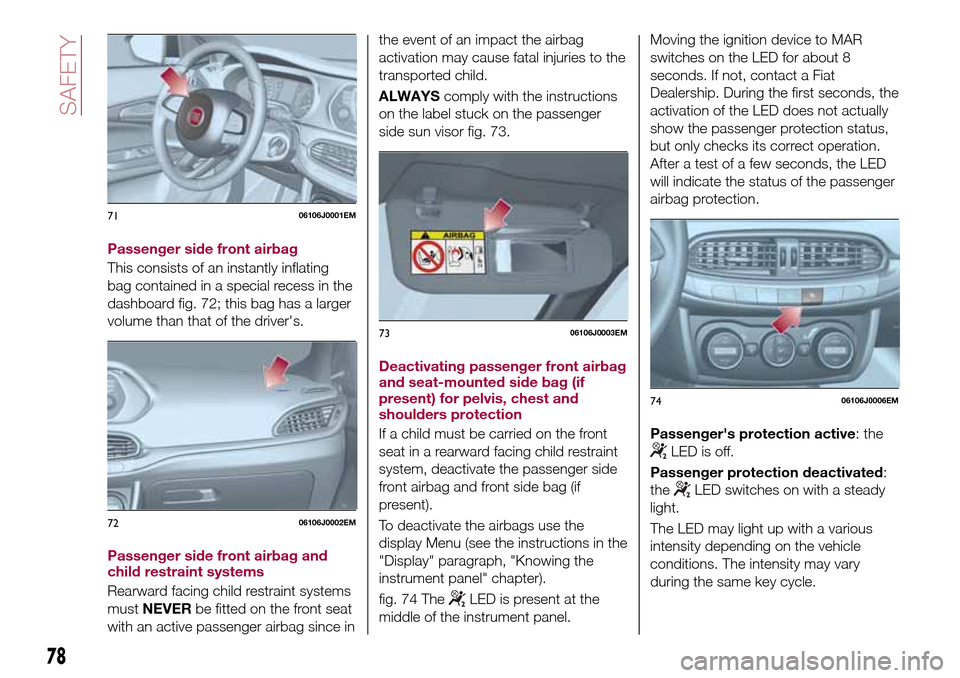
Passenger side front airbag
This consists of an instantly inflating
bag contained in a special recess in the
dashboard fig. 72; this bag has a larger
volume than that of the driver's.
Passenger side front airbag and
child restraint systems
Rearward facing child restraint systems
mustNEVERbe fitted on the front seat
with an active passenger airbag since inthe event of an impact the airbag
activation may cause fatal injuries to the
transported child.
ALWAYScomply with the instructions
on the label stuck on the passenger
side sun visor fig. 73.
Deactivating passenger front airbag
and seat-mounted side bag (if
present) for pelvis, chest and
shoulders protection
If a child must be carried on the front
seat in a rearward facing child restraint
system, deactivate the passenger side
front airbag and front side bag (if
present).
To deactivate the airbags use the
display Menu (see the instructions in the
"Display" paragraph, "Knowing the
instrument panel" chapter).
fig. 74 The
LED is present at the
middle of the instrument panel.Moving the ignition device to MAR
switches on the LED for about 8
seconds. If not, contact a Fiat
Dealership. During the first seconds, the
activation of the LED does not actually
show the passenger protection status,
but only checks its correct operation.
After a test of a few seconds, the LED
will indicate the status of the passenger
airbag protection.
Passenger's protection active: the
LED is off.
Passenger protection deactivated:
the
LED switches on with a steady
light.
The LED may light up with a various
intensity depending on the vehicle
conditions. The intensity may vary
during the same key cycle.
7106106J0001EM
7206106J0002EM
7306106J0003EM
7406106J0006EM
78
SAFETY